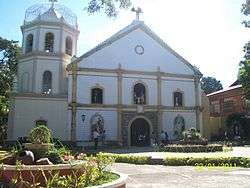San Juan, Ilocos Sur
| San Juan | ||
|---|---|---|
| Municipality | ||
 | ||
| ||
 Map of Ilocos Sur showing the location of San Juan | ||
.svg.png) San Juan Location within the Philippines | ||
| Coordinates: 17°43′45″N 120°27′39″E / 17.72917°N 120.46083°ECoordinates: 17°43′45″N 120°27′39″E / 17.72917°N 120.46083°E | ||
| Country | Philippines | |
| Region | Ilocos (Region I) | |
| Province | Ilocos Sur | |
| District | 1st District | |
| Barangays | 32 | |
| Government[1] | ||
| • Mayor | Benjamin Viloria Sarmiento | |
| Area[2] | ||
| • Total | 64.37 km2 (24.85 sq mi) | |
| Population (2010)[3] | ||
| • Total | 25,199 | |
| • Density | 390/km2 (1,000/sq mi) | |
| Time zone | PST (UTC+8) | |
| ZIP code | 2731 | |
| Dialing code | 77 | |
| Income class | 3rd class | |
San Juan (formerly Lapog) is a third class municipality in the province of Ilocos Sur, Philippines. According to the 2010 census, it has a population of 25,199 people.[3]
Because it produces most of the goods made of buri leaf in the province, it is sometimes called the Buri Capital of Ilocos Sur.
History
The town of Lapog was established in 1772.
The name of the municipality has gone through a series of changes. The early settlers and occupants called it "Lapo", short for "Lapo-Lapo", a tall grass which grew everywhere in the area. In the year 1772, Don Tomas Aquino, the first local leader, initiated the organization of the scattered communities into one, calling the place "Lapog", a derivative of local vernacular "Lap-Lapog" which means unirrigated land. For 189 years, "Lapog" remained in the records as the official name of the town until June 18, 1961, Republic Act No. 3386 was enacted and it was renamed to San Juan. Since most of the inhabitants were of the belief that religious names bring peace, happiness, and prosperity, the town was renamed "San Juan", after the name of its patron saint, Saint John the Baptist.
It was stricken by all sorts of plagues and epidemics (like the smallpox epidemics of 1808 and 1918–19, locust infestation in 1903, and destruction of ricefields by worms called "arabas" in 1905). Bessang Pass, just south of the poblacion, was constructed in 1874. Americans destroyed their town hall in 1903. But despite these misfortunes, San Juan progressed into a prosperous community.
Barangays
San Juan is politically subdivided into 32 barangays.[2]
- Asilang
- Bacsil
- Baliw
- Bannuar (Pob.)
- Barbar
- Cabanglotan
- Cacandongan
- Camanggaan
- Camindoroan
- Caronoan
- Darao
- Dardarat
- Guimod Norte
- Guimod Sur
- Immayos Norte
- Immayos Sur
- Labnig
- Lapting
- Lira (Pob.)
- Malamin
- Muraya
- Nagsabaran
- Nagsupotan
- Pandayan (Pob.)
- Refaro
- Resurreccion (Pob.)
- Sabangan
- San Isidro
- Saoang
- Solotsolot
- Sunggiam
- Surngit
Demographics
| Population census of San Juan | ||
|---|---|---|
| Year | Pop. | ±% p.a. |
| 1990 | 20,328 | — |
| 1995 | 21,222 | +0.81% |
| 2000 | 23,146 | +1.88% |
| 2007 | 23,808 | +0.39% |
| 2010 | 25,199 | +2.09% |
| Source: National Statistics Office[3][4] | ||
See also
References
- ↑ "Official City/Municipal 2013 Election Results". Intramuros, Manila, Philippines: Commission on Elections (COMELEC). 11 September 2013. Retrieved 25 September 2013.
- 1 2 "Province: ILOCOS SUR". PSGC Interactive. Makati City, Philippines: National Statistical Coordination Board. Retrieved 25 September 2013.
- 1 2 3 "Total Population by Province, City, Municipality and Barangay: as of May 1, 2010" (PDF). 2010 Census of Population and Housing. National Statistics Office. Retrieved 25 September 2013.
- ↑ "Province of Ilocos Sur". Municipality Population Data. LWUA Research Division. Retrieved 25 September 2013.
External links
- Act renaming the Municipality of Lapog to San Juan
- Pasyalang Ilocos Sur
- Lapog ... our town, our home
- Lapoguenio Perspectives
- Philippine Standard Geographic Code
- Philippine Census Information
- Local Governance Performance Management System
 |
Cabugao | Nueva Era, Ilocos Norte |  | |
| South China Sea | |
Bangued, Abra | ||
| ||||
| | ||||
| Magsingal | Langiden, Abra |
